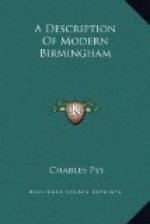The next avenue, in point of importance, is Camphill, on the road to Stratford, where several streets and roads are united.
It is deserving of notice, that however large or small the houses are, the partition walls are uniformly brick and mortar, and with few exceptions, the floors of small houses are laid with quarries, which in a great degree accounts for there being so few fires of any consequence within this extensive town.
There is not any thing in this town, or its immediate vicinity, that can attract the attention of an antiquarian: it appears that there once was a castle, encircled by a moat, situated near the Icknield-street, or Warstone-lane; the foundation of which is still perceptible, and covered an area of twenty square perch; but the ground whereon it stood has been so frequently turned over, that it is only by the difference in the verdure that it can be discovered.
The present occupier of the land has at different times taken up about four thousand of the bricks, which were burnt very hard, and resembled those now in use, but were not so large.
About four miles distant there once stood Weoliegh castle, which was surrounded by a moat; but the site of the castle is now a garden, and not a vestige of the building remains, except a small part of the foundation, which may be discovered at the edge of the moat, that remaining entire.
Having concluded my observations respecting the public concerns of Birmingham, I cannot restrain myself from remarking, that there is at Warwick castle a most magnificent marble bacchanalian vase, of astonishing dimensions, it being seven feet in diameter and twenty-one in circumference, which is encircled on the outside with fruit, leaves, and branches of the vine, the latter being entwined so as to form two massive handles, with grotesque masks at the end of each; the whole being in exact proportion to the magnitude of the vase. This unique specimen of ancient sculpture was discovered in the baths of the Emperor Adrian, and presented by the Queen of Naples to Sir Wm. Hamilton, the British ambassador at that court, by whom it was forwarded as a present to the late Earl of Warwick; who, when it was unpacked, and he had taken a survey of it, immediately gave orders for the erection of a splendid green-house, wherein it is now deposited.
Mr. E. Thomason, of this town, who had been a pupil of the late Mr. Boulton, at Soho, no sooner saw this remarkable production of the fine arts, than he conceived the idea of forming one of the same magnitude in metal; and accordingly solicited permission to make models from it, which his lordship in the most condescending manner permitted him to do. Mr. Thomason without delay made preparations for the undertaking, and the metallic vase has been under the hands of different artists above four years, and is now nearly completed. This unique performance in metal, is in every respect a perfect resemblance of the original, and weighs several tons; the ground of it is bronzed, and at the present time highly relieved in light and shade; but I understand it will, when complete, be considerably more so, by two novel and distinct processes of oxydation, that will endure for ages.




